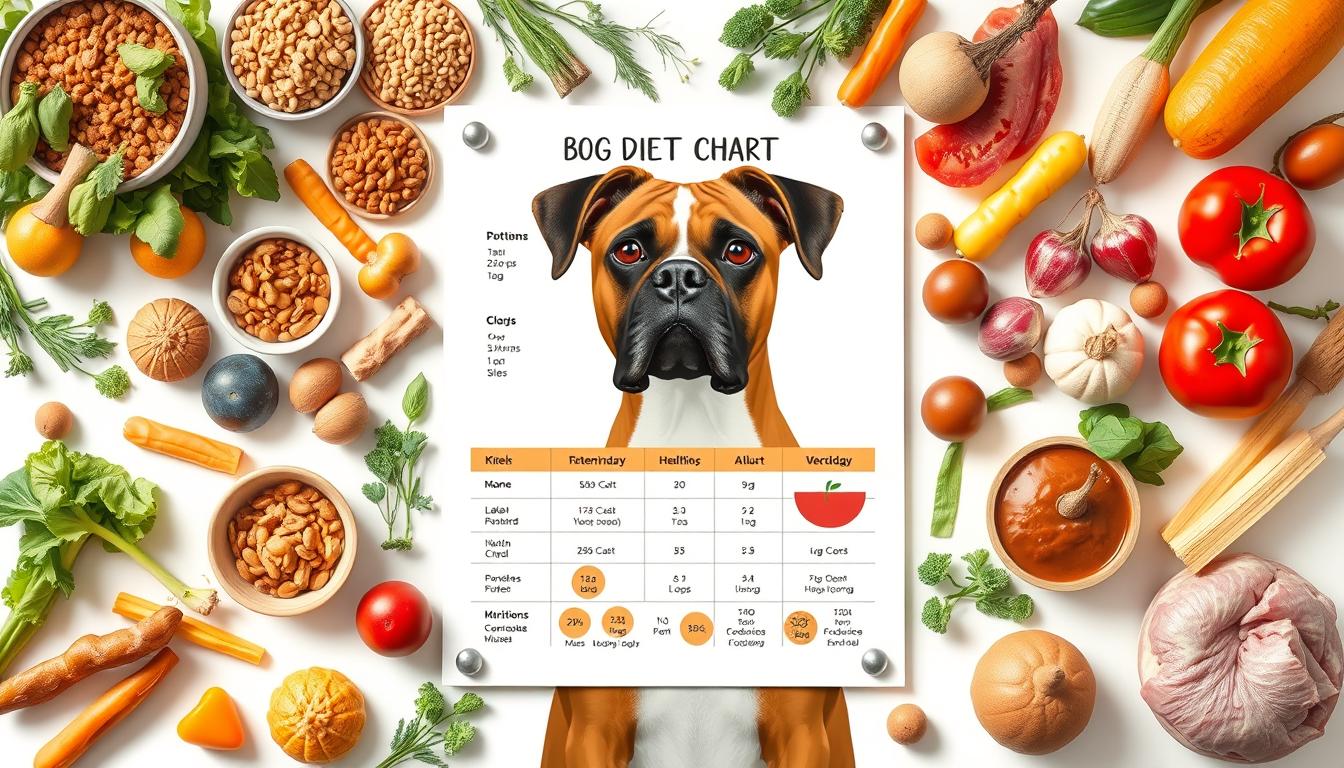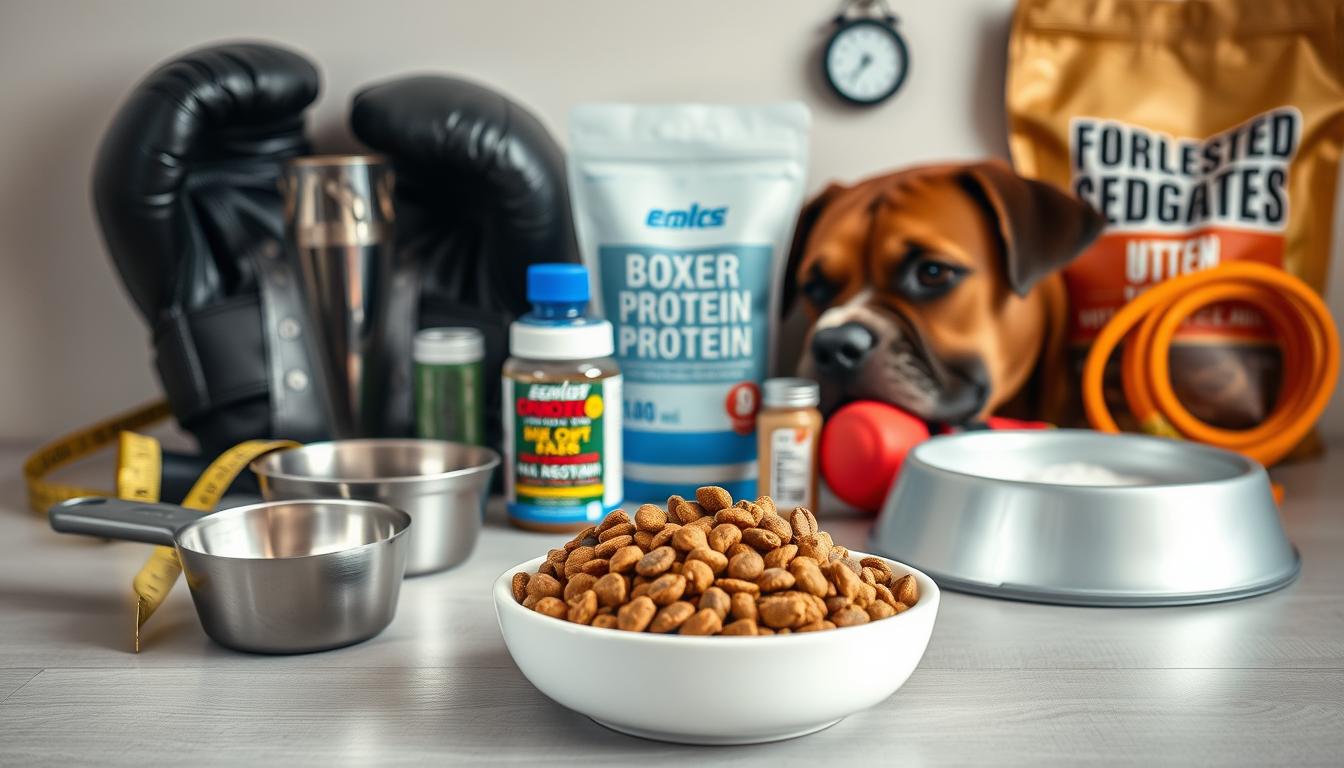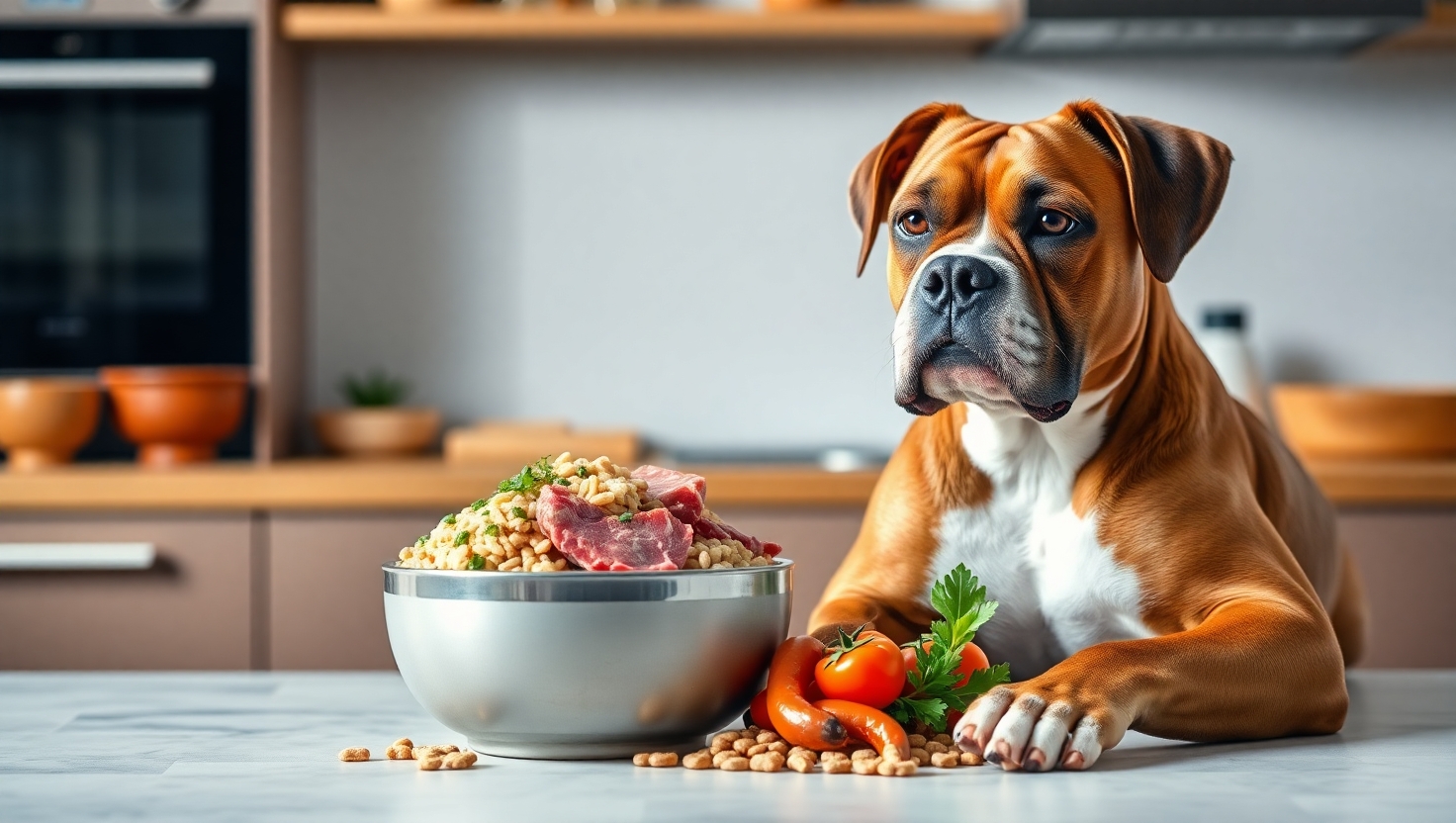Keeping your muscular, energetic four-legged friend healthy starts with proper nutrition. These athletic pets thrive on carefully balanced meals that fuel their playful nature and support their unique physique. Whether you’re raising a spirited puppy or caring for a mature adult, understanding their nutritional needs ensures they stay vibrant at every life stage.

Active breeds require tailored meal plans to maintain energy levels and muscle tone. Adults typically need 2.5–3 cups of quality kibble daily, divided into two portions. Puppies benefit from smaller, more frequent feedings to support rapid growth. Always consider activity levels when determining portions – a weekend hiking partner may need more fuel than a leisurely walker.
Transitioning between foods? Do it gradually over 7–10 days to avoid digestive issues. Look for formulas rich in lean proteins and healthy fats, while avoiding fillers that offer empty calories. Pair their meals with 30–120 minutes of daily exercise to create the perfect balance for a happy, healthy companion.
Key Takeaways
- Tailor meal plans to support high energy levels and muscle maintenance
- Adult portions average 2.5–3 cups daily across two meals
- Puppies need 3–4 smaller meals for proper development
- Adjust food amounts based on daily activity patterns
- Prioritize protein-rich formulas with essential nutrients
- Transition foods gradually to prevent stomach upset
Introduction to Boxer Dog Nutrition
The secret to a thriving, energetic companion lies in a meticulously crafted meal plan. Athletic breeds require specific nutrient combinations to maintain their signature stamina and lean physique. Their bodies demand fuel that matches their lively personalities and supports lifelong vitality.

Three core components form the foundation of optimal nutrition for active pets:
| Nutrient | Purpose | Ideal Sources |
|---|---|---|
| High-quality protein | Muscle repair & development | Chicken, turkey, fish |
| Healthy fats | Sustained energy & coat health | Salmon oil, flaxseed |
| Complex carbs | Digestive support & fuel | Sweet potatoes, peas |
Quality ingredients make all the difference. Look for whole-food formulas that deliver essential nutrients without unnecessary fillers. This approach helps maintain ideal weight while supporting joint function and cardiovascular health.
Every active pet’s needs vary based on age and exercise routine. Regular check-ins with your vet ensure their meals evolve with changing requirements. Pair smart feeding choices with plenty of playtime for complete wellness.
Understanding Your Boxer’s Dietary Needs
Proper nourishment transforms daily meals into building blocks for vitality. These energetic companions require carefully balanced nutrients to sustain their playful energy and maintain muscle tone. Their unique metabolism thrives on specific ratios of proteins, fats, and carbs tailored to an active lifestyle.

Nutritional Requirements for Optimal Health
Muscle maintenance starts with high-quality protein—aim for formulas where real meat tops the ingredient list. These proteins support heart function and tissue repair. Omega-3 fatty acids keep skin supple and promote cognitive health, while complex carbs like sweet potatoes provide steady fuel.
Essential vitamins and minerals often go unnoticed but play critical roles. They strengthen immunity, aid bone development, and ensure efficient nutrient absorption. Always pair these elements with proper hydration for maximum benefit.
Key Ingredients: Protein, Fats, and Carbohydrates
Prioritize chicken, beef, or fish as primary protein sources. These deliver amino acids necessary for lean muscle preservation. Healthy fats from salmon oil or flaxseed offer concentrated energy and support organ function.
Carbohydrates should come from whole-food sources like brown rice or oats. These options digest slowly, preventing energy crashes and supporting digestive regularity. Avoid fillers like corn or wheat that offer minimal nutritional value.
Boxer Dog Diet Chart: A Step-by-Step Feeding Guide
Tailored feeding schedules match your pet’s zest for life and nutritional demands. Age and daily movement patterns determine how much to offer at each serving. Let’s break down the essentials for creating a customized plan.

Meal Planning by Age and Activity Level
Younger companions need frequent fuel for growth spurts – three to four small portions daily work best. Mature adults thrive on two main meals spaced 12 hours apart. Active pets who hike or train daily may require 15-20% more food than couch-loving counterparts.
| Life Stage | Daily Meals | Calorie Range | Activity Notes |
|---|---|---|---|
| Puppy (2-12 mo) | 3-4 | 55 cal/lb | High growth needs |
| Adult (1-7 yrs) | 2 | 40 cal/lb | Adjust based on exercise |
| Senior (7+ yrs) | 2-3 | 35 cal/lb | Lower mobility = less intake |
Portion Sizes and Caloric Intake
Measure each amount using a kitchen scale for accuracy. A 20-pound youngster typically needs 1,100 calories daily, while a 65-pound adult might require 1,800-2,200.
“Always start with manufacturer guidelines, then adjust based on body condition and energy output,”
advises veterinary nutritionist Dr. Ellen Cho.
Track weekly weight changes and energy levels. Reduce portions if waistlines disappear, or increase meals for pets who tire quickly during play. Pair this monitoring with regular vet checkups for optimal results.
Transitioning from Puppy Food to Adult Diet
Timing meals to match growth phases ensures your energetic companion gets the right fuel at every stage. Young athletes need different nutritional support as they shift from rapid development to maintaining muscle and stamina.

Identifying Growth Milestones
Most reach full size between 16-18 months, though some keep growing until age two. Watch for slowed height increases and consistent weight over 3-4 weeks. Veterinarians recommend waiting until growth plates close before switching formulas.
Gradual Dietary Adjustments
Start blending adult and puppy meals over 7-10 days. Begin with 25% new food mixed into their usual portion. Increase by 10-15% daily while tracking stool quality and appetite.
| Transition Day | Puppy Food | Adult Food |
|---|---|---|
| 1-2 | 75% | 25% |
| 3-4 | 50% | 50% |
| 5-7 | 25% | 75% |
| 8-10 | 0% | 100% |
Slow the process if loose stools occur. Offer probiotics or pumpkin to ease digestion. Complete the switch once they consistently enjoy their new meals without tummy troubles.
Managing Health Issues Through a Balanced Diet
Proactive nutrition choices can shield your active companion from common breed-specific ailments. Many muscular breeds face particular challenges that require targeted dietary solutions. Strategic meal planning helps address these concerns while maintaining energy and vitality.

Supporting Heart Health and Joint Function
Cardiovascular wellness starts with omega-3 fatty acids from sources like sardines or algae supplements. These nutrients help maintain steady heart rhythms and reduce inflammation. Keep sodium levels moderate to ease blood pressure demands on this hardworking organ.
For joint support, maintain lean muscle through protein-rich meals while managing weight. Excess pounds strain hips and knees, worsening conditions like dysplasia. Glucosamine-rich foods or supplements can add extra cushioning for active lifestyles.
Preventing Bloat, Obesity, and Food Allergies
Feed three smaller meals daily instead of one large portion to minimize bloat risks. Use ground-level bowls and discourage rapid eating. Watch for restlessness or swollen abdomens – early intervention saves lives.
Regular weigh-ins help spot obesity trends before they impact mobility. If allergies surface, eliminate common triggers like chicken or wheat systematically. Skin irritations or digestive upset often signal ingredient sensitivities needing attention.
Special Considerations for Boxer Puppies and Adults
Every life stage brings new nutritional priorities for your energetic companion. Youngsters and mature pets have distinct metabolic needs that require precise adjustments. Let’s explore how to fuel their bodies optimally during these critical phases.

Puppy-Specific Nutritional Needs
Growing pups need 28-32% protein in their meals to build strong muscles. Calcium levels should stay between 1.2-1.8% to support bone development without causing joint stress. Large-breed formulas help manage growth speed through controlled calorie density.
| Nutrient | Puppy Requirement | Adult Requirement |
|---|---|---|
| Protein | 28-32% | 22-26% |
| Fat | 12-16% | 10-14% |
| Calcium | 1.2-1.8% | 0.8-1.2% |
Adjustments for Mature Boxers
Senior pets often thrive on 18-22% protein content with reduced calories. Look for glucosamine supplements and antioxidant-rich ingredients like blueberries. Metabolic rates drop about 20% by age seven, requiring careful portion monitoring.
| Senior Needs | Solution | Benefit |
|---|---|---|
| Joint health | Glucosamine | Improved mobility |
| Weight control | L-carnitine | Fat metabolism |
| Cognitive support | Omega-3 DHA | Brain function |
Regular vet checkups help fine-tune these nutritional strategies. Pair age-specific meals with appropriate exercise routines for complete wellness support.
Tips for Preventing Overfeeding and Managing Weight
Smart serving sizes and regular activity form the foundation of lifelong health. Active breeds often burn calories quickly, but portion discipline ensures they stay lean without missing essential nutrients. Consistency matters more than quantity when creating sustainable habits.
Effective Portion Control Techniques
Precise measurement tools prevent accidental overfeeding. Use a kitchen scale or measuring cup instead of guessing amounts. Track every meal to maintain accuracy—even small daily extras add up over time.
Divide daily intake into two meals spaced 8-12 hours apart. This approach stabilizes energy levels and prevents hunger spikes. Adjust portions if your companion exercises more than usual on certain days.
Assess body condition weekly by gently feeling along the ribcage. You should detect ribs with light pressure but not see them protruding. Reduce how much you feed if waistlines become less defined.
- Weigh portions instead of using cup measurements for accuracy
- Limit treats to 10% of daily calories
- Schedule feeding times rather than free-feeding
Record weight trends monthly using the same scale. Sudden changes often signal needed adjustments. Pair these strategies with 45-60 minutes of daily play to maintain ideal physique.
Incorporating Quality Treats and Supplements
Smart snacking strategies enhance your pet’s nutrition while strengthening your bond. Thoughtful additions to meals can address specific needs without disrupting their balanced food routine. Let’s explore how to choose rewards and boosters that complement their main meals.
Choosing Healthy Snacks
Opt for single-ingredient rewards like freeze-dried liver or crunchy carrots. These options pack flavor without empty calories. Avoid products with artificial colors or preservatives that might trigger allergies or skin irritation.
Fresh fruits and vegetables make excellent low-calorie choices. Blueberries offer antioxidants, while green beans provide fiber. Always remove seeds and pits, and introduce new items gradually to monitor reactions.
| Treat Type | Benefits | Calories per Serving |
|---|---|---|
| Dehydrated sweet potato | High in fiber | 15 |
| Air-dried salmon | Rich in omega-3s | 25 |
| Fresh apple slices | Vitamin C source | 10 |
The Role of Supplements in Daily Nutrition
Targeted additives can resolve specific problems when approved by your vet. Fish oil supports coat shine and joint mobility, while probiotics aid digestion. Always choose products designed for active breeds.
Consult your veterinary team before introducing new supplements. They’ll recommend proper dosages based on weight and health history. Monitor for changes in energy levels or skin condition to assess effectiveness.
- Limit treats to 10% of daily calories
- Store supplements in childproof containers
- Check expiration dates monthly
Regular checkups help identify nutritional gaps needing supplementation. Pair these extras with quality meals and plenty of exercise for complete wellness support.
Conclusion
Optimal health for your Boxer is a collaborative effort between you and your vet. Choosing AAFCO-approved kibble or wet food ensures balanced nutrition tailored to this active breed’s needs. Regular checkups help catch common health issues early, from heart murmurs to skin sensitivities, giving your companion their best shot at a full 10–12 year lifespan.
Adjust meals as your canine friend ages—puppies and seniors have different calorie requirements. Pair quality nutrition with daily exercise to maintain muscle tone and mental sharpness. Always consult your veterinary team when introducing new foods or managing allergies.
By staying attentive to changing needs and prioritizing vet-recommended choices, you’ll fuel countless adventures together. Remember: what goes into the bowl today shapes tomorrow’s tail wags and playful leaps.
FAQ’s
How much protein should a Boxer’s diet include?
Aim for high-quality animal protein sources like chicken, beef, or fish, making up 22–25% of their diet. Active pups and adults need this for muscle development and sustained energy.
What’s the best way to prevent bloat in this breed?
Serve smaller, frequent meals instead of one large portion. Avoid vigorous exercise right after eating, and use slow-feed bowls to reduce gulping air during meals.
When should I switch my puppy to adult food?
Transition around 12–14 months once growth slows. Mix adult kibble with puppy food over 7–10 days to avoid digestive upset. Consult your vet for breed-specific timing.
Are grain-free diets safe for Boxers?
Not always. Some grain-free formulas link to heart issues in susceptible breeds. Opt for whole grains like brown rice or oats unless allergies are confirmed by a vet.
How often should I feed my adult Boxer?
Split daily portions into two meals to maintain energy levels and prevent overeating. Adjust amounts based on activity—working dogs may need 10–20% more calories.
Can treats cause weight gain in this active breed?
Yes! Keep snacks under 10% of daily calories. Try low-calorie options like carrots or blueberries. Avoid fatty, processed treats that contribute to obesity.
Do Boxers need joint supplements as they age?
Glucosamine and chondroitin can support joint health, especially after age 5. Discuss options like Dasuquin or Cosequin with your vet for early arthritis prevention.
How do I know if my Boxer has food allergies?
Look for itchy skin, ear infections, or digestive issues. Common triggers include beef, dairy, or wheat. An elimination diet with novel proteins like salmon can help identify culprits.
What’s a healthy weight range for this muscular breed?
Males typically weigh 65–80 lbs, females 50–65 lbs. You should feel—but not see—their ribs. A visible waistline when viewed from above signals ideal body condition.
Also Read:


